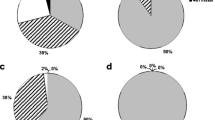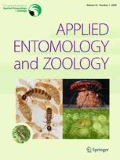Abstract
The quality of pollen of tea (Camellia sinensis L.), big leaf podocarp tree [Podocarpus macrophyllus (Thumb.)] and sweet corn (Zea mays L.) as alternative food sources was evaluated for seven native phytoseiid mite species, Amblyseius eharai Amitai and Swirski, Euseius sojaensis (Ehara), Neoseiulus californicus (McGregor), Neoseiulus womersleyi (Schicha), Phytoseius nipponicus Ehara, Chanteius contiguus (Chant) and Typhlodromus vulgaris Ehara. Tea pollen was of high nutritional value for all seven phytoseiid species: most larvae developed to adults and most females oviposited well. Development and oviposition differed greatly among phytoseiid species when reared on big leaf podocarp tree pollen: A. eharai, T. vulgaris and C. contiguus could utilize the pollen as food, but the other phytoseiid species could not. In addition, big leaf podocarp tree pollen could be utilized by A. eharai as food for longer than the other pollen. The quality of sweet corn pollen was inferior in general, although it could somehow favor the development and oviposition of six phytoseiid species except for E. sojaensis.
Similar content being viewed by others

References
Addison JA, Hardman JM, Walde S (2000) Pollen availability for predaceous mites on apple: spatial and temporal heterogeneity. Exp Appl Acarol 24:1–18
Amano H, Kawashima M, Matsumura M, Saito M, Toyoshima S (2011) Description of an unrecorded phytoseiid mite, Neoseiulus harrowi (Collyer), from Japanese spinach greenhouses. J Acarol Soc Jpn 20:95–102
Barbosa P (1998) Conservation biological control. Academic Press, San Diego
Castagnoli M, Simoni S (1999) Effect of long-term feeding history on functional and numerical response of Neoseiulus californicus (Acari: Phytoseiidae). Exp Appl Acarol 23:217–234. doi:10.1023/A:1006066930638
Duso C, Malagnini V, Paganelli A, Aldegheri L, Bottini M (2002) Phytoseiid mites pollen relationships: observations in a vineyard and the surrounding vegetation. In: Bernini F, Nannelli R, Nuzzaci G, de Lillo E (eds) Acarid phylogeny and evolution. Kluwer Academic Publishers, Dordrecht, pp 375–389
Ehara S, Gotoh T (eds) (2009) Colored guide to the plant mites of Japan. Zenkoku Noson Kyoiku Kyokai, Tokyo (in Japanese)
Gotoh T, Yamaguchi K, Mori K (2004) Effect of temperature on life history of the predatory mite Amblyseius (Neoseiulus) californicus (Acari: Phytoseiidae). Exp Appl Acarol 32:15–30. doi:10.1023/B:APPA.0000018192.91930.49
Hamamura T (1986) Studies on the biological control of kanzawa spider mite, Tetranychus kanzawai Kishida, by the chemical resistant predacious mite, Amblyseius longispinosus (Evans) in tea fields (Acarina: Tetranychidae, Phytoseiidae). Bull Tea Res Sta 21:122–197 (in Japanese with English summary)
Ito M, Iyama Y, Ueki K (1987) Changes in the floristic composition of orchard ground cover in relation to light conditions. J Weed Sci Tech 32:292–299 (in Japanese with English summary)
Kennett CE, Flaherty DL, Hoffmann RW (1979) Effects of wind borne pollens on the population dynamics of Amblyseius hibisci (Acarina: Phytoseiidae). Entomophaga 34:83–98
Kishimoto H (2002) Species composition and seasonal occurrence of spider mites (Acari: Tetranychidae) and their predators in Japanese pear orchards with different agrochemical spraying programs. Appl Entomol Zool 37:603–615
Kishimoto H (2005) A new technique for efficient rearing of phytoseiid mites. Appl Entomol Zool 40:77–81
Kishimoto H, Teshiba M, Kondoh T, Miyazaki T, Sugiura N, Toda S, Yamasaki R, Wakatsuki H, Motoyama H, Horie H (2007) Occurrence of Neoseiulus californicus (Acari: Phytoseiidae) on citrus in the Kyushu district, Japan. J Acarol Soc Jpn 16:129–137 (in Japanese with English summary)
Komi K, Arakawa R, Amano H (2008) Native phytoseiid mites (Acari: Phytoseiidae) occurring on greenhouse vegetable crops under the pest control programs with natural enemies in Kochi prefecture, Japan. J Acarol Soc Jpn 17:23–28 (in Japanese with English summary)
Kondo A, Hiramatsu T (1999) Predatory ability of two species of phytoseiid mites (Acari: Phytoseiidae) on the peach silver mite, Aculus fockeui (Nalepa et Trouessart) (Acari: Eriophyidae). Appl Entomol Zool 34:485–487
Kunimoto Y, Nakama T, Amano H, Takafuji A (2009) Species composition of predators of spider mites in persimmon orchards in Nara Prefecture with reference to the effect of weed management. J Acarol Soc Jpn 18:7–16 (in Japanese with English summary)
Landis DA, Wratten SD, Gurr GM (2000) Habitat management to conserve natural enemies of arthropod pests in agriculture. Annu Rev Entomol 45:175–201
McMurtry JA, Croft BA (1997) Life-styles of phytoseiid mites and their roles in biological control. Annu Rev Entomol 42:291–321
Miyazaki T, Kishimoto H, Suga Y, Teramoto T (2012) The Occurrence of the native natural enemy of citrus red mite in citrus orchard in Nagasaki Prefecture. Bullt Nagasaki A & F Tech Dev Cen 3:121–139 (in Japanese with English summary)
Nomikou M, Sabelis MW, Janssen A (2010) Pollen subsidies promote whitefly control through the numerical response of predatory mites. Biocontrol 55:253–260. doi:10.1007/s10526-009-9233-x
Ohno S, Gotoh T, Miyagi A, Ganaha-Kikumura T, Kurima M, Kijima K, Ooishi T (2012) Geographic distribution of phytoseiid mite species (Acari: Phytoseiidae) on crops in Okinawa, a subtropical area of Japan. Entomol Sci 15:115–120. doi:10.1111/j.1479-8298.2011.00469.x
Osakabe M, Inoue K, Ashihara W (1986) Feeding, reproduction and development of Amblyseius sojaensis Ehara (Acarina: Phytoseiidae) on two species of spider mites and on tea pollen. Appl Entomol Zool 21:322–327
Overmeer WPJ (1985a) Alternative prey and other food resources. In: Helle W, Sabelis MW (eds) Spider mites: their biology, natural enemies and control vol 1B. Elsevier, Amsterdam, pp 131–139
Overmeer WPJ (1985b) Rearing and handling. In: Helle W, Sabelis MW (eds) Spider mites: their biology, natural enemies and control vol 1B. Elsevier, Amsterdam, pp 161–170
Saito Y, Mori H (1975) The effects of pollen as an alternative food for three species of phytoseiid mites (Acarina: Phytoseiidae). Mem Fac Agr Hokkaido Univ 9:236–246 (in Japanese with English summary)
SAS Institute (1998) StatView user’s manual, version 5. SAS Institute, Cary
Suzuki K (1992) Changes of the weed flora caused by changes of cultivation techniques -Orchard-. J Weed Sci Tech 37:195–203 (in Japanese)
Takebayashi T (1985) Observation on the population shift of weeds in citrus orchard. J Weed Sci Tech 30:237–244 (in Japanese)
Toyoshima S (2003) A candidate of predatory phytoseiid mites (Acari: Phytoseiidae) for the control of the European red mite, Panonychus ulmi (Koch), (Acari: Tetranychidae) in Japanese apple orchards. Appl Entomol Zool 38:387–391
Toyoshima S, Amano H (2006) Diversity and abundance of phytoseiid mites on Magnolia hypoleuca Siebold et Zuccarini, a candidate source of natural enemies in natural vegetation. Appl Entomol Zool 41:349–355
Toyoshima S, Ihara F, Amano H (2008) Diversity and abundance of phytoseiid mites in natural vegetation in the vicinity of apple orchards in Japan. Appl Entomol Zool 43:443–450
van Rijn PCJ, Tanigoshi LK (1999) Pollen as food for the predatory mites Iphiseius degenerans and Neoseiulus cucumeris (Acari: Phytoseiidae): dietary range and life history. Exp Appl Acarol 23:785–802
Wäckers FL (2005) Suitability of (extra-) floral nectar, pollen, and honeydew as insect food sources. In: Wäckers FL, van Rijn PCJ, Bruin J (eds) Plant-provided food for carnivorous insects: a protective mutualism and its applications. Cambridge University Press, Cambridge, pp 17–74
Wade MR, Zalucki MP, Wratten SD, Robinson KA (2008) Conservation biological control of arthropods using artificial food sprays: current status and future challenges. Biol Control 45:185–199
Acknowledgments
This study was partly supported by the Ministry of Agriculture, Forestry and Fisheries, Japan through a research project entitled “Development of technologies for mitigation and adaptation to climate change in Agriculture, Forestry and Fisheries”.
Author information
Authors and Affiliations
Corresponding author
Rights and permissions
About this article
Cite this article
Kishimoto, H., Ohira, Y. & Adachi, I. Effect of different plant pollens on the development and oviposition of seven native phytoseiid species (Acari: Phytoseiidae) in Japan. Appl Entomol Zool 49, 19–25 (2014). https://doi.org/10.1007/s13355-013-0218-y
Received:
Accepted:
Published:
Issue Date:
DOI: https://doi.org/10.1007/s13355-013-0218-y



